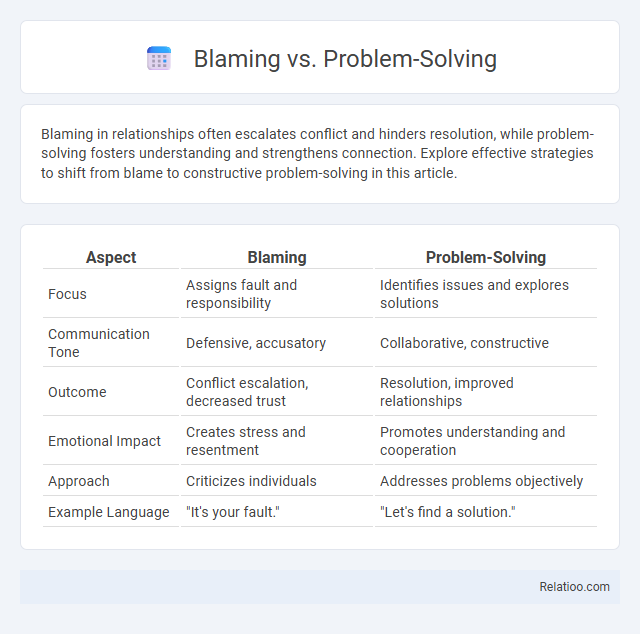Blaming in relationships often escalates conflict and hinders resolution, while problem-solving fosters understanding and strengthens connection. Explore effective strategies to shift from blame to constructive problem-solving in this article.
Table of Comparison
| Aspect | Blaming | Problem-Solving |
|---|---|---|
| Focus | Assigns fault and responsibility | Identifies issues and explores solutions |
| Communication Tone | Defensive, accusatory | Collaborative, constructive |
| Outcome | Conflict escalation, decreased trust | Resolution, improved relationships |
| Emotional Impact | Creates stress and resentment | Promotes understanding and cooperation |
| Approach | Criticizes individuals | Addresses problems objectively |
| Example Language | "It's your fault." | "Let's find a solution." |
Understanding the Roots of Blaming
Blaming often stems from a need to assign responsibility and avoid accountability, clouding the ability to identify the true causes of issues. Understanding the roots of blaming requires examining underlying emotions such as fear, insecurity, and defensiveness that hinder constructive dialogue. Shifting focus toward problem-solving encourages a collaborative mindset aimed at uncovering actionable solutions rather than perpetuating conflict.
The Psychology Behind Problem-Solving
The psychology behind problem-solving involves cognitive processes that engage analytical thinking, creativity, and emotional regulation to identify effective solutions. Unlike blaming, which triggers defensive responses and hinders constructive dialogue, problem-solving fosters collaboration and promotes a growth mindset essential for overcoming challenges. Studies in cognitive psychology highlight that individuals who adopt problem-solving strategies exhibit higher resilience and improved emotional intelligence, driving better decision-making outcomes in complex situations.
How Blaming Hinders Progress
Blaming creates a cycle of negativity that stalls progress by shifting focus away from solutions to assigning fault, which prevents Your team from addressing root causes effectively. Problem-solving encourages collaboration and innovation by prioritizing actionable steps and learning opportunities over personal attacks. When blame dominates, communication breaks down, trust erodes, and productivity declines, making it difficult to implement meaningful change.
Benefits of a Problem-Solving Mindset
A problem-solving mindset fosters innovation and resilience by encouraging individuals to identify root causes and develop effective solutions rather than assigning fault. This approach enhances collaboration and trust within teams, leading to improved communication and a more positive organizational culture. Emphasizing problem-solving over blaming reduces stress and increases productivity by creating a forward-thinking environment focused on continuous improvement.
Common Triggers That Lead to Blame
Common triggers that lead to blaming include stress, fear of failure, and lack of control, which shift focus away from collaborative problem-solving. When confronted with unexpected challenges, your natural reaction might be to assign fault as a defense mechanism rather than analyze the root cause. Understanding these triggers enables you to redirect energy towards constructive solutions and improve team dynamics.
Steps to Shift from Blame to Solution
Identify the root cause of the issue by gathering relevant facts and avoiding assumptions, which helps shift your mindset from blame to understanding. Encourage open communication and active listening among team members to foster a collaborative environment that prioritizes solutions over fault-finding. Develop actionable steps together, setting clear goals and responsibilities to ensure accountability and progress toward resolving the problem effectively.
Building a Culture of Accountability
Building a culture of accountability involves shifting focus from blaming individuals to problem-solving processes that identify root causes and implement sustainable solutions. Emphasizing transparent communication and collective responsibility encourages team members to learn from mistakes rather than fear punishment. Organizations that prioritize problem-solving foster innovation, improve performance, and create an environment where accountability drives continuous improvement.
Communication Strategies for Resolution
Effective communication strategies for resolution prioritize problem-solving over blaming to foster collaboration and mutual understanding. You can enhance conflict resolution by focusing on clear, empathetic dialogue that identifies issues without assigning fault, encouraging constructive feedback and solution-oriented discussions. Emphasizing active listening and open-ended questions helps transform blame-centered conversations into opportunities for growth and teamwork.
Real-World Examples: Blaming vs Problem-Solving
Blaming creates barriers to effective communication and collaboration, often seen in workplace conflicts where team members point fingers instead of seeking solutions. Problem-solving encourages constructive dialogue and innovation, exemplified by companies like Toyota that implement Lean methodologies to identify and resolve process inefficiencies. Your ability to shift from blaming to problem-solving can transform challenges into opportunities for growth and improved performance.
Creating Lasting Change Through Problem-Solving
Creating lasting change through problem-solving involves shifting the focus from blaming individuals to identifying root causes and implementing effective solutions. This approach fosters collaboration, encourages accountability, and drives continuous improvement within organizations or personal contexts. Emphasizing problem-solving over blaming cultivates a proactive mindset that supports sustainable growth and innovation.

Infographic: Blaming vs Problem-Solving
 relatioo.com
relatioo.com